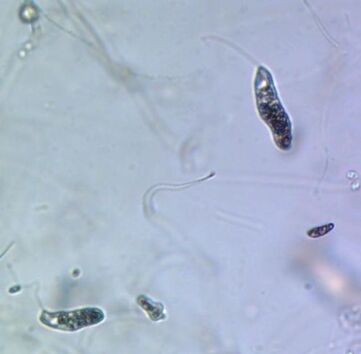|
Euglena are tiny protists that are classified in the Eukaryota Domain and the genus Euglena. These single-celled eukaryotes have characteristics of both plant and animal cells. Like plant cells, some species are photoautotrophs and have the ability to use light to produce nutrients through photosynthesis. Like animal cells, other species are heterotrophs and acquire nutrition from their environment by feeding on other organisms. Euglena can be found in ponds, lakes, and streams, as well as in waterlogged land areas like marshes.*
Typically, euglena has two flagella. Flagellum (plural: flagella) is a long whip-like structure at the front of the euglena cells. One is long and can be seen under a light microscope, but the other is very short without protruding from the cells. The function of flagella is to help euglena swim. The Euglena moves by whipping and turning its flagella in a way like a propeller. The beating of the flagella creates two motions. One is moving the Euglena forward, and the other one is rotating the Euglena's body. Euglena also has a bright red eyespot, also called stigma. It is made up of carotenoid pigment granules. The eyespot is not an actual eye; instead, it is more like a sunglass for a photoreceptor. The eyespot filters the sunlight and allows certain wavelengths of light to reach photoreceptors. Therefore, the eyespot can tell the euglena where the light source comes from.** |
|
*Information from: Bailey, Regina. "Euglena Cells." ThoughtCo, Feb. 16, 2021, thoughtco.com/about-euglena-cells-4099133.
**Information from: Rachel; "Euglena" https://rsscience.com/euglena/
**Information from: Rachel; "Euglena" https://rsscience.com/euglena/

